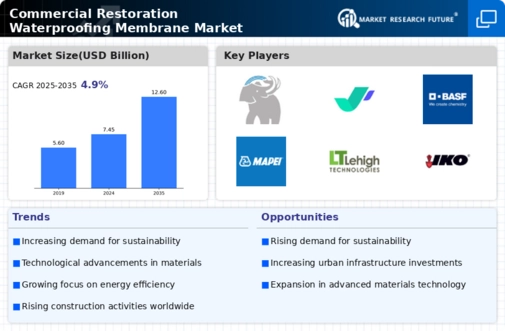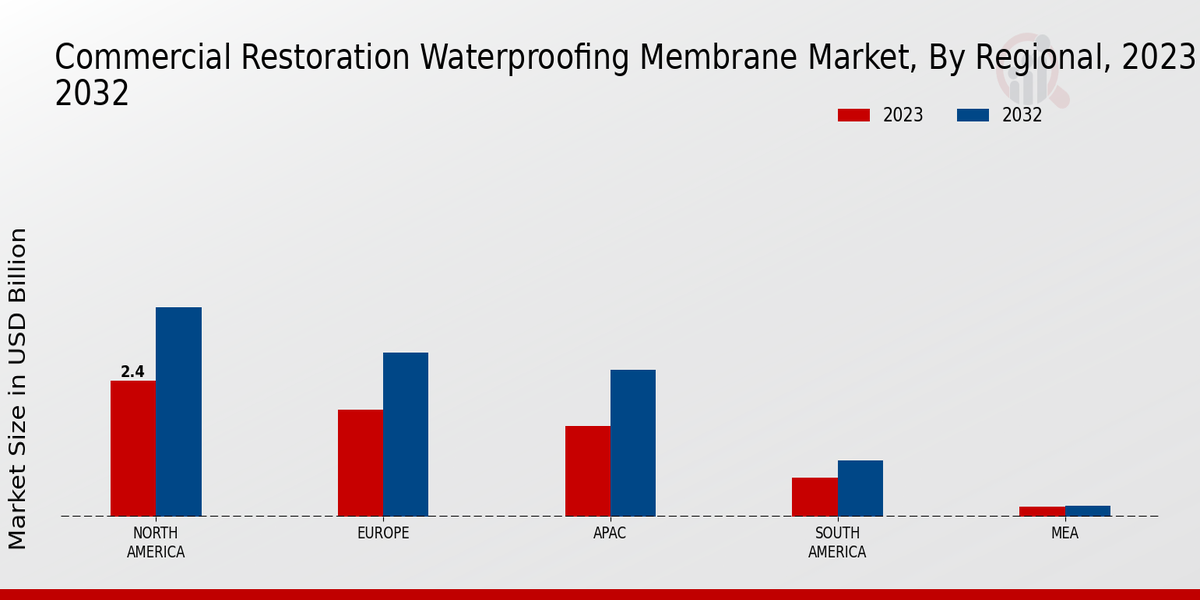Market Growth Projections
Increasing Infrastructure Development
The Global Commercial Restoration Waterproofing Membrane Market Industry is experiencing growth driven by rising infrastructure development across various regions. Governments are investing heavily in infrastructure projects, including roads, bridges, and commercial buildings, which necessitate effective waterproofing solutions. For instance, the global market is projected to reach 7.45 USD Billion in 2024, reflecting the increasing demand for durable and reliable waterproofing membranes. This trend is particularly evident in urban areas where the need for sustainable construction practices is paramount. As infrastructure projects expand, the demand for high-performance waterproofing membranes is likely to increase, thereby propelling market growth.
Rising Awareness of Building Longevity
There is a growing awareness among builders and property owners regarding the importance of building longevity, which significantly influences the Global Commercial Restoration Waterproofing Membrane Market Industry. Effective waterproofing membranes are essential for protecting structures from water damage, mold, and deterioration. This awareness is leading to increased investments in quality waterproofing solutions, as property owners recognize that upfront costs can lead to long-term savings. The market is expected to grow as more stakeholders prioritize the durability and lifespan of their buildings, with projections indicating a market value of 12.6 USD Billion by 2035. This trend underscores the critical role of waterproofing in modern construction.
Regulatory Standards and Building Codes
The Global Commercial Restoration Waterproofing Membrane Market Industry is significantly influenced by stringent regulatory standards and building codes aimed at enhancing construction quality and safety. Governments and regulatory bodies are increasingly mandating the use of high-performance waterproofing solutions in commercial buildings to mitigate risks associated with water damage. Compliance with these regulations not only ensures the safety of structures but also promotes the adoption of advanced waterproofing technologies. As a result, manufacturers are compelled to innovate and improve their product offerings to meet these standards, thereby driving market growth. This regulatory landscape is expected to continue evolving, further impacting the industry.
Environmental Sustainability Initiatives
Environmental sustainability initiatives are becoming a crucial driver for the Global Commercial Restoration Waterproofing Membrane Market Industry. As global awareness of environmental issues increases, there is a growing demand for eco-friendly waterproofing solutions that minimize environmental impact. Manufacturers are responding by developing sustainable products that meet both performance and environmental standards. This shift towards sustainability is likely to attract environmentally conscious consumers and businesses, thereby expanding the market. The emphasis on green building practices is expected to contribute to the overall growth of the industry, aligning with global efforts to reduce carbon footprints and promote sustainable construction.
Technological Advancements in Waterproofing Solutions
Technological advancements are playing a pivotal role in shaping the Global Commercial Restoration Waterproofing Membrane Market Industry. Innovations in materials and application techniques have led to the development of more efficient and effective waterproofing membranes. For example, the introduction of self-healing membranes and advanced polymer technologies enhances the performance and lifespan of these products. As these technologies become more widely adopted, they are likely to drive market growth, attracting new investments and applications in various sectors. The anticipated compound annual growth rate (CAGR) of 4.88% from 2025 to 2035 indicates a robust future for the industry, fueled by continuous innovation.























